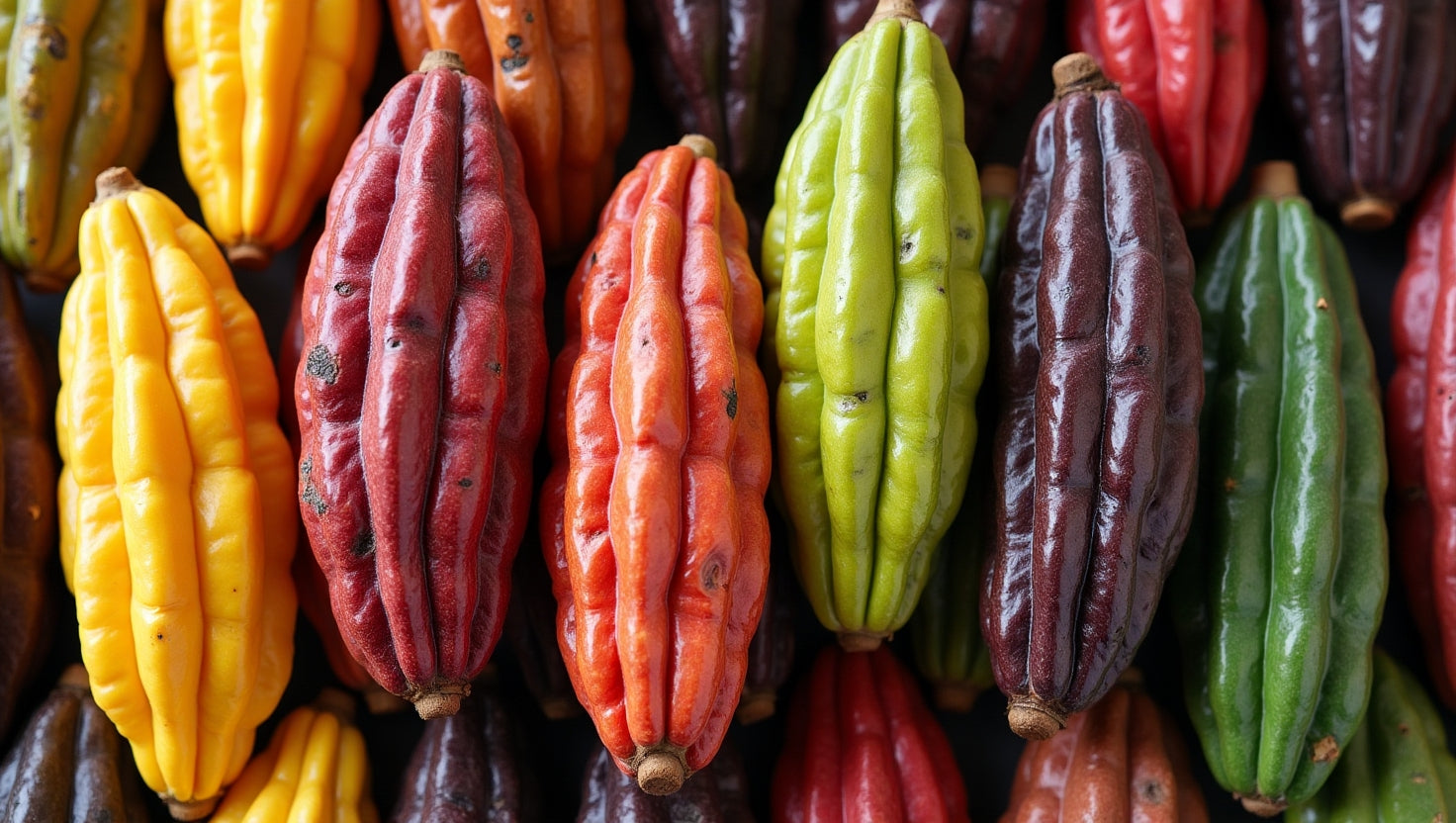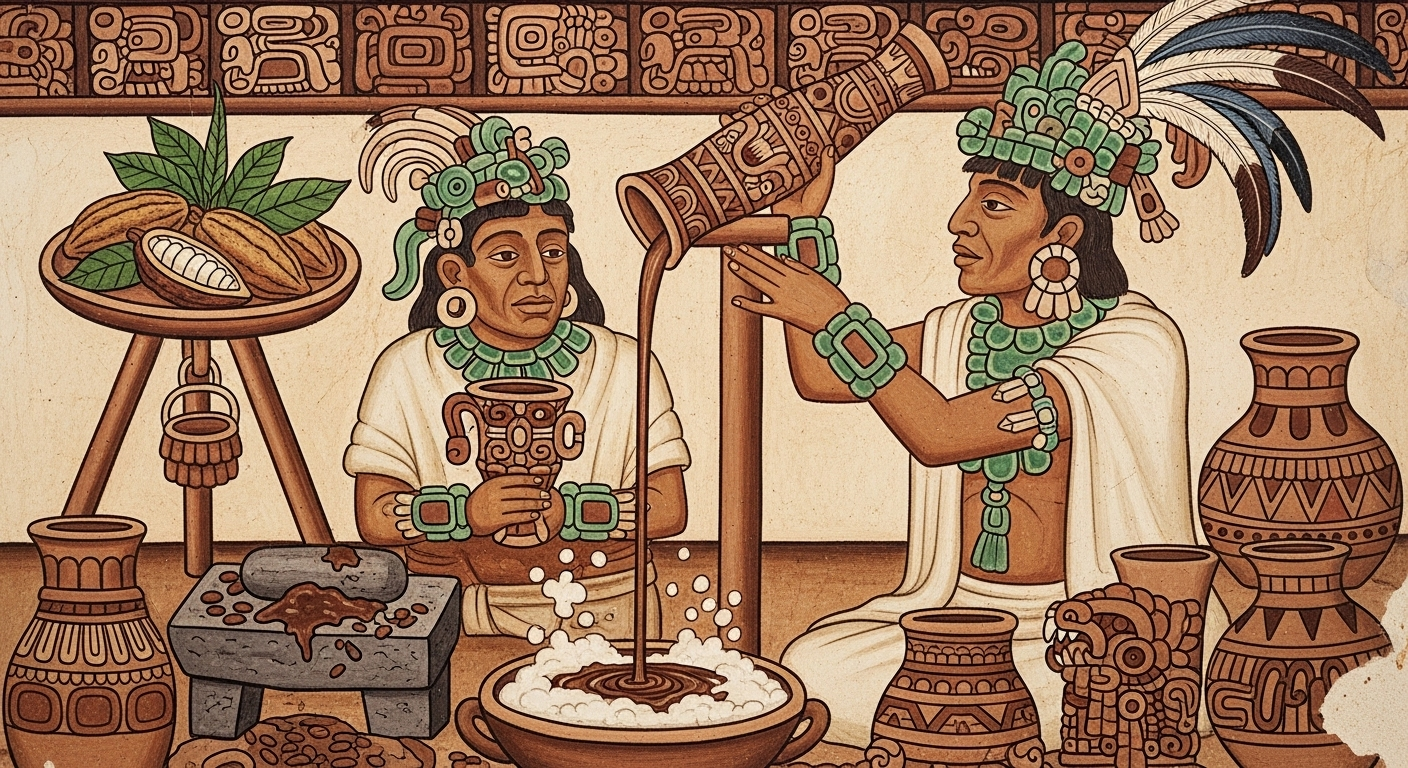
Cacao Pods: Nature's Extraordinary Chocolate Treasure
Few foods can trace their origins to something as visually striking as the cacao pod – the colorful, elongated fruit that contains the seeds (or beans) from which all chocolate is made. These remarkable botanical treasures have captivated humans for millennia, from ancient Mesoamerican civilizations who first discovered their potential to modern chocolate makers who continue to unlock their complex flavors. At Coracao Confections, our chocolate journey begins with these extraordinary fruits, which is why we're passionate about sharing the fascinating world of cacao pods with chocolate lovers everywhere.
What Exactly Is a Cacao Pod?
The cacao pod is the fruit of the Theobroma cacao tree, whose scientific name appropriately translates to "food of the gods." These tropical trees produce pods directly from their trunks and main branches – a unique growing pattern called cauliflory that makes cacao harvesting possible despite the trees' relatively small stature (typically 15-25 feet tall when cultivated).
Each pod is a botanical marvel: oval-shaped, typically 6-10 inches long and 3-4 inches wide, with a thick, leathery rind protecting the precious contents inside. When ripe, a single pod contains approximately 30-50 almond-sized seeds nestled in a sweet, white pulp. It's these seeds, once fermented, dried, roasted, and processed, that eventually become the chocolate we know and love.
What's particularly striking about cacao pods is their remarkable diversity of colors and shapes. Depending on the variety, pods can be vibrant yellow, deep red, purple, or various shades of green, often transitioning between colors as they ripen. Their exteriors may be smooth, warty, or deeply furrowed, making them one of the most visually distinctive fruits in the plant kingdom.

The Fascinating Life Cycle of Cacao Pods
The journey of a cacao pod from flower to harvest offers a glimpse into the complex biology that makes chocolate possible. Unlike many fruit trees that flower seasonally, cacao trees can produce flowers year-round in the right climate conditions, though they typically have two main fruiting periods annually.
From Delicate Flower to Developing Pod
The cacao's tiny, star-shaped flowers emerge directly from the trunk and older branches in clusters called cushions. These diminutive blossoms (measuring just 1-2 cm) are primarily pollinated by specialized midges – tiny flies that inhabit the forest understory where cacao naturally grows. This specific pollination requirement explains why cacao trees thrive in their native rainforest habitat with particular environmental conditions.
In a remarkable display of biological efficiency, only about 1-5% of cacao flowers are successfully pollinated and develop into pods. This low success rate is nature's way of ensuring the tree doesn't expend energy growing more fruit than it can support. Once pollinated, the flowers develop into pods that take 5-6 months to fully mature – an unusually long development time for a fruit.
The Ripening Process
As cacao pods develop, they undergo a striking transformation. Young pods are typically green or red regardless of their final color, gradually changing as they mature. The ripening process involves not just color changes but also shifts in pod texture and internal development. Farmers skilled in cacao cultivation can recognize subtle signs of ripeness that might escape the untrained eye.
A fully ripe pod contains beans surrounded by a sweet, white pulp that bears little resemblance to chocolate in flavor. This mucilaginous pulp, while delicious and often enjoyed fresh in cacao-growing regions, serves an important biological purpose: attracting animals that disperse the seeds in the wild. In cultivation, however, this pulp becomes crucial during the fermentation process, providing the sugars that fuel the microbial activity that begins developing chocolate's precursor flavors.
Major Varieties of Cacao Pods
The diversity of cacao pods reflects thousands of years of both natural evolution and human selection. Broadly speaking, cacao varieties fall into several main genetic groups, each with distinctive characteristics that influence the flavor profile of the resulting chocolate.
Criollo: The Aristocrat of Cacao
Criollo cacao pods are often elongated with a pronounced point and typically display red to yellow coloration when ripe. They're prized for their complex, delicate flavor profiles with notes of caramel, nuts, vanilla, and minimal bitterness. Unfortunately, Criollo trees produce fewer pods and are more susceptible to disease, making them rare – comprising less than 5% of world production. The pods contain beans that are usually white to pale purple inside, unlike the deep purple interior of most other varieties.
Forastero: The Workhorse of the Chocolate Industry
Forastero cacao pods are typically shorter, rounder, and have a smoother surface than Criollo pods. When ripe, they range from yellow to orange. Forastero represents approximately 80% of global cacao production due to its vigor, disease resistance, and higher yield. The beans inside Forastero pods are purple and produce chocolate with strong, earthy flavors and more pronounced bitterness. While sometimes considered less complex than fine flavor varieties, well-processed Forastero can produce excellent chocolate with distinctive character.
Trinitario: The Hybrid Vigor
Trinitario cacao pods show significant variation in appearance, reflecting their nature as natural hybrids between Criollo and Forastero. They can display characteristics from both parent varieties in pod shape, color, and texture. This genetic group originated in Trinidad (hence the name) and combines some of the flavor complexity of Criollo with the hardiness of Forastero. The pods contain beans that vary from light to dark purple, producing chocolate with balanced flavor profiles that often include fruity, spicy, and woody notes.
Nacional: Ecuador's Treasure
Nacional cacao pods are distinctive for their elongated shape and deep furrows. While technically a subset of Forastero, Nacional is recognized for its exceptional flavor profile, often described as floral with notes of jasmine and orange blossom. True Nacional cacao was thought to be extinct until recently, when isolated populations were discovered in remote valleys of Ecuador. The pods produce beans with a unique aroma that commands premium prices in the specialty chocolate market.

From Pod to Chocolate: The Remarkable Transformation
Understanding how cacao pods become chocolate reveals the extraordinary complexity behind this beloved food. The journey involves multiple crucial steps that gradually transform the raw seeds into the complex, meltable delight we recognize as chocolate.
Harvesting: The Critical First Step
Harvesting cacao requires precision and care. Since pods don't ripen simultaneously, skilled farmers identify ripe pods based on color changes, sound (ripe pods make a hollow sound when tapped), and subtle textural cues. Using machetes or specialized tools, workers carefully cut pods from the tree without damaging the cushions where future flowers will grow.
This labor-intensive process cannot be mechanized, as each pod must be individually assessed and harvested by hand. After collection, pods are typically opened within 2-3 days, as leaving harvested pods intact for too long can negatively affect flavor development.
Opening the Treasure Chest
Breaking open a cacao pod reveals a sight that might surprise chocolate lovers – rows of beans covered in a white, sweet pulp that bears no resemblance to chocolate in appearance or taste. This pulp, called mucilage or baba, is tangy-sweet and delicious, with tropical fruit flavors that vary by cacao variety.
The pod opening process typically happens at centralized locations on farms, where workers skillfully split pods with machetes or wooden mallets, being careful not to damage the beans inside. The beans and pulp are scooped out, leaving behind the thick pod husks which are often returned to the plantation as compost.
The Magic of Fermentation
The critical first processing step occurs when the fresh beans, still coated in their sweet pulp, are placed in fermentation boxes or covered with banana leaves. During the 5-7 day fermentation process, microorganisms consume the pulp's sugars, generating heat and transforming the beans biochemically.
This fermentation accomplishes several crucial developments:
- The beans' cell walls break down
- Bitter compounds decrease
- Flavor precursors develop
- Color changes from purple to brown
- Moisture decreases
Properly fermented beans contain over 600 aromatic compounds and flavor precursors – the building blocks of chocolate's complex flavor. At Coracao, we carefully select beans that have been optimally fermented to ensure our chocolate expresses the full potential of the original cacao pod.

Cacao Pod Diversity: The Terroir of Chocolate
Just as wine grapes express terroir – the environmental factors affecting a crop – cacao pods develop distinctive characteristics based on their growing conditions. This diversity translates directly to flavor differences in the finished chocolate.
Geographic Origins and Flavor Profiles
Cacao pods from different regions typically develop distinctive flavor characteristics:
- Central and South American pods (particularly from countries like Venezuela, Ecuador, and Peru) often produce beans with floral, fruity, and nut-like flavor notes
- Caribbean cacao pods frequently develop spicy, tobacco, and dried fruit characteristics
- West African pods (from Ghana, Côte d'Ivoire) typically yield beans with earthy, robust flavor profiles and subtle bitter notes
- Southeast Asian cacao pods (particularly from Indonesia and Vietnam) often produce chocolate with smoky, woody notes and sometimes distinctive spice characteristics
This regional diversity explains why single-origin chocolates, like those in our Single Origin Collection, can offer such distinctive tasting experiences – they express the unique characteristics of cacao pods from specific terroirs.
Seasonal Variations
Even cacao pods from the same farm can vary seasonally. Factors like rainfall patterns, temperature fluctuations, and sunlight exposure affect pod development and, consequently, flavor. Some chocolate makers, particularly those working directly with farmers, can identify subtle differences between main and mid-crop harvests from the same location.
Sustainable Cultivation: The Future of Cacao Pods
As global demand for chocolate continues to rise, ensuring sustainable cultivation of cacao pods becomes increasingly important. Several challenges face cacao production, including:
Climate Change Concerns
The cacao tree has specific climate requirements, thriving only in a narrow band approximately 20 degrees north and south of the equator, with precise temperature, humidity, and rainfall needs. Climate change threatens these delicate growing conditions, potentially reducing viable growing regions and increasing susceptibility to diseases and pests.
Genetic Diversity Preservation
Preserving cacao genetic diversity is crucial for the future of chocolate. Many fine flavor varieties face extinction pressure as farmers switch to higher-yielding, disease-resistant varieties that may lack distinctive flavor characteristics. Seed banks and conservation efforts aim to maintain this biodiversity – not just for flavor but also for breeding resilient varieties for the future.
Ethical Considerations
The human element of cacao pod cultivation cannot be overlooked. Fair compensation for the skilled labor required to grow and harvest cacao pods remains a challenge in the industry. At Coracao, we prioritize ethically sourced cacao from operations where farmers receive fair compensation for their expertise and labor.
Frequently Asked Questions About Cacao Pods
Can you eat raw cacao pod pulp?
How many cacao pods are needed to make a chocolate bar?
How long does it take for a cacao tree to produce pods?
Why do cacao pods grow directly from the trunk?
What happens to cacao pod husks after harvesting?
The Cacao Pod: Nature's Perfect Chocolate Package
The humble cacao pod represents one of nature's most remarkable creations – a fruit that contains within it the potential for extraordinary complexity and pleasure. From its vibrant exterior to the precious beans nestled inside, every aspect of the cacao pod has evolved perfectly to protect and nurture the seeds that become chocolate.
When you consider the journey from rainforest tree to finished chocolate bar, the cacao pod's role becomes even more impressive. These colorful fruits grow in some of the most biodiverse regions on Earth, requiring specific climatic conditions and ecological relationships to thrive. Their successful cultivation depends on the expertise of farmers who understand the subtle rhythms of the cacao tree, recognizing precisely when each pod reaches perfect ripeness.
At Coracao Confections, our appreciation for the cacao pod influences every aspect of our chocolate making. By honoring the bean's origins, using traditional stone-grinding techniques that preserve more of cacao's natural compounds, and carefully selecting ethically sourced beans, we create chocolate that reflects the remarkable potential contained within each pod.
Experience the Journey from Pod to Bar
The next time you enjoy a piece of fine chocolate, take a moment to appreciate the extraordinary fruit that made it possible. Through our Stone Ground Chocolate Collection, you can experience chocolate that preserves more of the natural characteristics present in the original cacao pod – a taste connection to tropical forests and the remarkable fruit that has captivated humans for millennia.
Curious to explore how different cacao pods translate to distinctive chocolate experiences? Try our Chocolate Sampler to taste the remarkable diversity that nature's most extraordinary fruit can express when transformed by careful, conscientious chocolate making.
Have you ever seen a cacao pod in person or tasted fresh cacao pulp? Share your experiences or questions about cacao pods in the comments below!

Claire Bennett
I'm Claire, a chocolate lover and artisan based in a small town where I run a tiny home kitchen dedicated to exploring everything chocolate. From single-origin dark bars to creamy ganache and handmade truffles, I find joy in working with all types of chocolate. I believe chocolate has a story, and I love bringing that story to life through humble, heartfelt creations.



Leave a comment
This site is protected by hCaptcha and the hCaptcha Privacy Policy and Terms of Service apply.